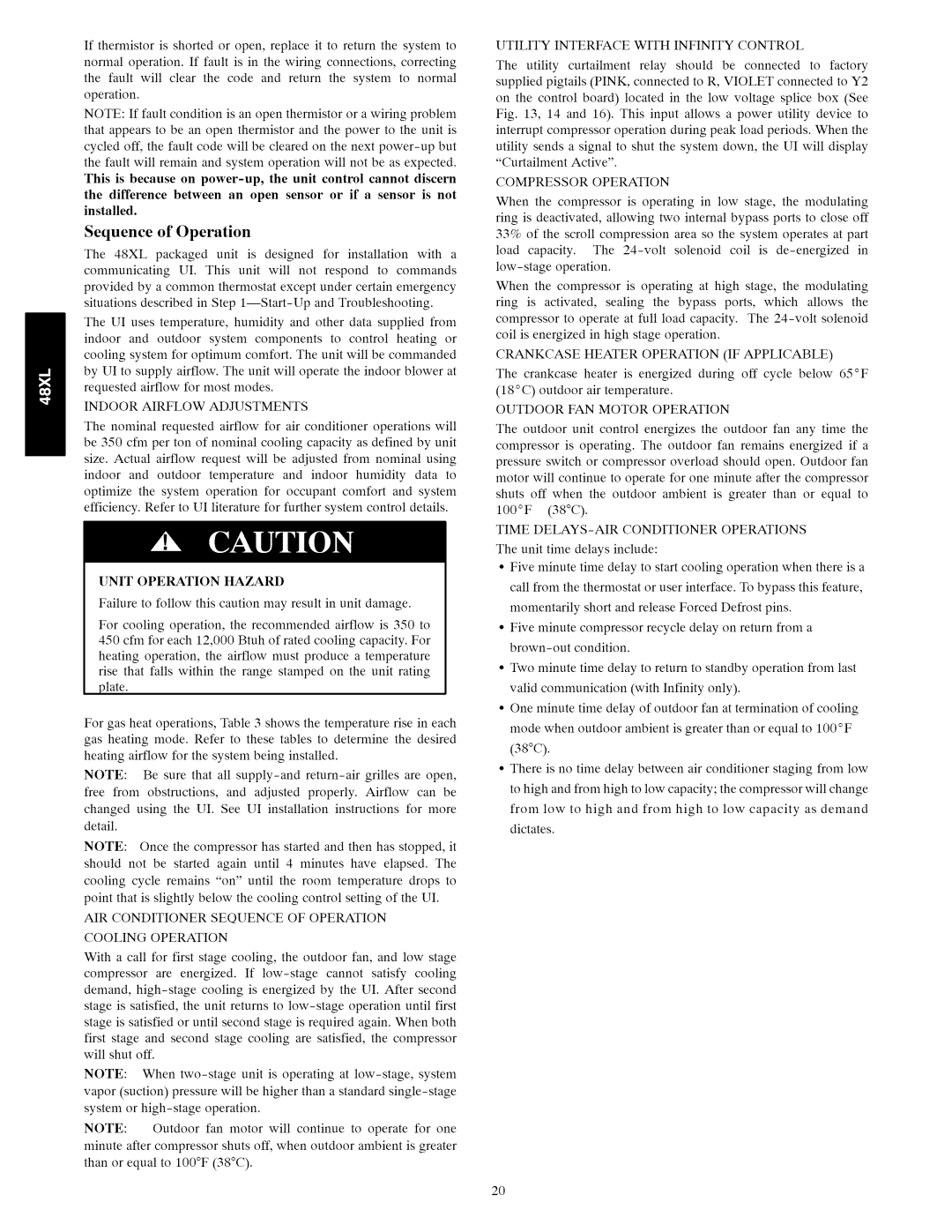
If thermistor is shorted or open, replace it to return the system to
normal operation. If fault is in the wiring connections, correcting the fault will clear the code and return the system to normal operation.
NOTE: If fault condition is an open thermistor or a wiring problem
that appears to be an open thermistor and the power to the unit is
cycled off, the fault code will be cleared on the next
This is because on
the difference between an open sensor or if a sensor is not installed.
Sequence of Operation
The 48XL packaged unit is designed for installation with a
communicating UI. This unit will not respond to commands
provided by a common thermostat except under certain emergency
situations described in Step
The UI uses temperature, humidity and other data supplied from
indoor and outdoor system components to control heating or cooling system for optimum comfort. The unit will be commanded by UI to supply airflow. The unit will operate the indoor blower at requested airflow for most modes.
INDOOR AIRFLOW ADJUSTMENTS
The nominal requested airflow for air conditioner operations will be 350 cfm per ton of nominal cooling capacity as defined by unit
size. Actual airflow request will be adjusted from nominal using
indoor and outdoor temperature and indoor humidity data to
optimize the system operation for occupant comfort and system efficiency. Refer to UI literature for further system control details.
UNIT OPERATION HAZARD
Failure to follow this caution may result in unit damage.
For cooling operation, the recommended airflow is 350 to 450 cfm for each 12,000 Btuh of rated cooling capacity. For
heating operation, the airflow must produce a temperature rise that falls within the range stamped on the unit rating plate.
For gas | heat | operations, | Table | 3 | shows | the | temperature | rise | in | each | ||||||
gas heating | mode. | Refer | to | these | tables | to determine | the | desired | ||||||||
heating | airflow | for | the | system | being | installed. |
|
|
|
|
| |||||
NOTE: | Be | sure | that | all | grilles | are | open, | |||||||||
free from | obstructions, | and | adjusted | properly. | Airflow | can | be | |||||||||
changed | using | the | UI. | See | UI | installation | instructions | for | more | |||||||
detail. |
|
|
|
|
|
|
|
|
|
|
|
|
|
|
|
|
NOTE: | Once | the | compressor |
| has | started | and | then has | stopped, | it | ||||||
should not be started again until 4 minutes have elapsed. The
cooling cycle remains :'on" until the room temperature drops to
point that is slightly below the cooling control setting of the UI.
AIR CONDITIONER SEQUENCE OF OPERATION
COOLING OPERATION
With a call for first stage cooling, the outdoor fan, and low stage
compressor | are energized. | If | cannot | satisfy | cooling | |||
demand, | cooling | is | energized | by | the | UI. After second | ||
stage is satisfied, | the unit returns | to | operation | until first | ||||
stage is satisfied or until second stage is required again. When both
first stage and second stage cooling are satisfied, the compressor will shut off.
NOTE: When
vapor (suction) pressure will be higher than a standard
system | or | operation. |
|
|
| |
NOTE: |
| Outdoor | fan motor | will continue | to operate | for one |
minute | after | compressor | shuts off, | when outdoor | ambient | is greater |
than or | equal | to 100°F | (38°C). |
|
|
|
UTILITY INTERFACE WITH INFINITY CONTROL
The utility curtailment relay should be connected to factory
supplied pigtails (PINK, connected to R, VIOLET connected to Y2 on the control board) located in the low voltage splice box (See Fig. 13, 14 and 16). This input allows a power utility device to
interrupt compressor operation during peak load periods. When the utility sends a signal to shut the system down, the UI will display
"Curtailment Active".
COMPRESSOR OPERATION
When the compressor is operating in low stage, the modulating
ring is deactivated, allowing two internal bypass ports to close off
33% of the scroll compression area so the system operates at part
load capacity. The
When the compressor is operating at high stage, the modulating
ring is activated, sealing the bypass ports, which allows the
compressor to operate at full load capacity. The
CRANKCASE HEATER OPERATION (IF APPLICABLE)
The crankcase heater is energized during off cycle below 65°F (18 ° C) outdoor air temperature.
OUTDOOR FAN MOTOR OPERATION
The outdoor unit control energizes the outdoor fan any time the
compressor is operating. The outdoor fan remains energized if a
pressure switch or compressor overload should open. Outdoor fan motor will continue to operate for one minute after the compressor
shuts off when the outdoor ambient is greater than or equal to
100°F (38°C).
TIME
•Five minute time delay to start cooling operation when there is a call from the thermostat or user interface. To bypass this feature,
momentarily short and release Forced Defrost pins.
•Five minute compressor recycle delay on return from a
•Two minute time delay to return to standby operation from last
valid communication (with Infinity only).
•One minute time delay of outdoor fan at termination of cooling mode when outdoor ambient is greater than or equal to 100°F
(38°C).
•There is no time delay between air conditioner staging from low to high and from high to low capacity; the compressor will change
from low to high and from high to low capacity as demand dictates.
20
